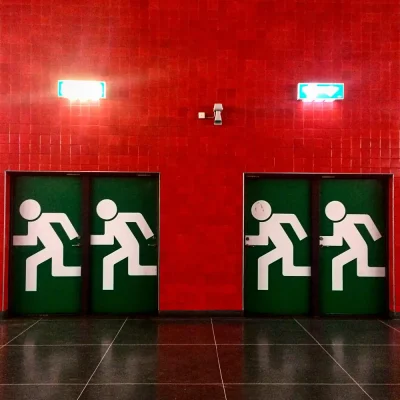The Role of Emergency Lighting in Building Evacuations
When an emergency strikes—whether it is a fire, earthquake, power failure, or security threat—the first few minutes are the most critical for saving lives. In such situations, people must evacuate a building quickly, calmly, and safely. However, darkness, smoke, or confusion can turn even a familiar environment into a dangerous maze. This is where emergency lighting systems play a vital role. They provide illumination when the main power supply fails, guiding occupants to exits and helping emergency responders carry out rescue operations efficiently.
This article explores the importance of emergency lighting in building evacuations, its role in fire and life safety, and why compliance with modern safety standards is essential for India’s rapidly urbanizing infrastructure.
Why Emergency Lighting Matters in Evacuation
Imagine being in a crowded office tower, shopping mall, or hospital when the power suddenly goes out. Without backup lighting, people may panic, staircases may become unsafe, and exits may be impossible to locate. Emergency lighting reduces these risks by:
- Providing clear visibility in corridors, stairwells, and exit routes.
- Preventing panic by offering reassurance through consistent illumination.
- Supporting safe navigation even in smoke-filled or obstructed conditions.
- Enabling emergency services to respond faster during rescue operations.
In simple terms, emergency lighting is the invisible lifeline of every evacuation plan. It doesn’t just guide people out of danger; it prevents accidents, stampedes, and disorientation that could otherwise lead to tragic consequences
Emergency lighting is not one-size-fits-all. Different environments require specific solutions to ensure complete coverage. The major categories include:
1. Escape Route Lighting
This ensures that exit doors, corridors, and staircases remain illuminated during an emergency. It clearly marks pathways to safety and helps prevent bottlenecks or confusion.
2. Open Area (Anti-Panic) Lighting
In large halls, lobbies, or public spaces, open area lighting reduces the chance of panic by maintaining adequate visibility, allowing people to orient themselves before moving toward exits.
3. High-Risk Task Area Lighting
In industries, laboratories, or hospitals, workers may be handling dangerous equipment or chemicals. Specialized emergency lights ensure that critical operations can be safely shut down before evacuation.
4. Exit Signage Lighting
Illuminated exit signs are as important as the lights themselves. They guide people directly to the nearest escape route, especially when multiple exits exist.
By integrating these categories, buildings create a seamless safety net that functions under every emergency scenario.

Emergency Lighting in Fire Evacuations
In fire-related incidents, visibility is one of the biggest challenges. Smoke spreads quickly, blocking natural light and reducing visibility to near zero. Emergency lighting with photoluminescent or LED-based technology helps occupants see floor markings, stair edges, and exit doors even in smoke-heavy conditions.
Fire safety codes in India, such as the National Building Code (NBC 2016), emphasize the role of emergency lighting in fire preparedness. Buildings that fail to comply risk not only legal penalties but also the safety of hundreds of lives during a crisis.
Legal and Regulatory Requirements in India
The importance of emergency lighting is well-recognized in safety standards. In India:
- NBC 2016 mandates emergency illumination in all high-rise and public buildings.
- Local fire authorities often require regular inspection and maintenance of emergency lighting systems as part of fire safety audits.
- Upcoming smart building codes integrate energy-efficient emergency lighting, ensuring sustainability alongside safety.
For architects, builders, and facility managers, compliance is not optional—it is a legal and moral responsibility.
Technology Advancements in Emergency Lighting
Modern emergency lighting has evolved far beyond basic backup bulbs. Today’s systems incorporate:
- LED-based fixtures that consume less energy and last longer.
- Self-testing units that automatically check functionality and alert managers of faults.
- Battery backup systems that provide extended illumination even during long power cuts.
- Smart integration with building management systems (BMS) for real-time monitoring.
- Sustainable options such as solar-powered emergency lights.
These innovations not only improve safety but also reduce operational costs and maintenance challenges for building owners.
Also read: What is building security and why is it important
Common Challenges in Emergency Lighting
Despite regulations, many buildings in India still face gaps in emergency lighting infrastructure. Common issues include:
- Non-functional lights due to lack of maintenance.
- Blocked or hidden exit signage in commercial complexes.
- Inadequate coverage in basements, staircases, or parking lots.
- Overdependence on natural light, which fails during smoke or night-time emergencies.
Such oversights can turn minor incidents into life-threatening disasters. Regular safety audits and timely upgrades are the best solutions.
Best Practices for Effective Emergency Lighting
To ensure maximum efficiency, building owners and managers should follow these best practices:
- Conduct regular testing to ensure batteries and bulbs are working.
- Install lights at correct heights in staircases and corridors.
- Ensure signage is visible from every angle, without obstruction.
- Comply with NBC and fire department guidelines during installation.
- Train building occupants on evacuation drills with emergency lighting in place.
When combined with fire alarms, sprinklers, and trained staff, emergency lighting becomes part of a comprehensive safety ecosystem.
Role of Emergency Lighting in Sustainable and Smart Buildings
With India moving toward smart cities and green infrastructure, emergency lighting is also evolving. Energy-efficient LED systems, solar-powered units, and IoT-enabled monitoring make these systems more reliable and environmentally friendly.
Smart buildings now integrate emergency lighting with other safety systems, allowing central monitoring of faults and automatic alerts during power failures. This ensures not just compliance but also proactive risk management.
Educating the Public on Emergency Lighting
Awareness is just as important as technology. Many people assume emergency lighting is only for commercial buildings, but residential apartments, schools, and healthcare facilities also need robust systems. Educating residents, employees, and visitors about the importance of these lights ensures people trust and follow evacuation routes during emergencies.
Conclusion
Emergency lighting is not just an accessory—it is a life-saving system. From guiding people out of dark corridors to preventing panic in crowded spaces, it plays a central role in every evacuation strategy. For India’s growing urban landscape, where high-rise buildings and complex infrastructures are becoming the norm, investing in reliable emergency lighting is an investment in safety and sustainability.
